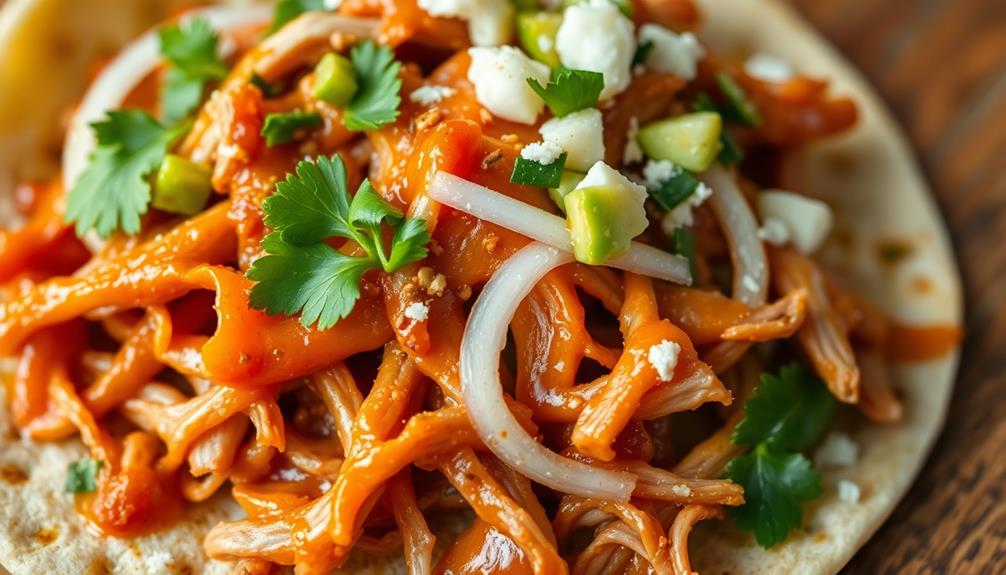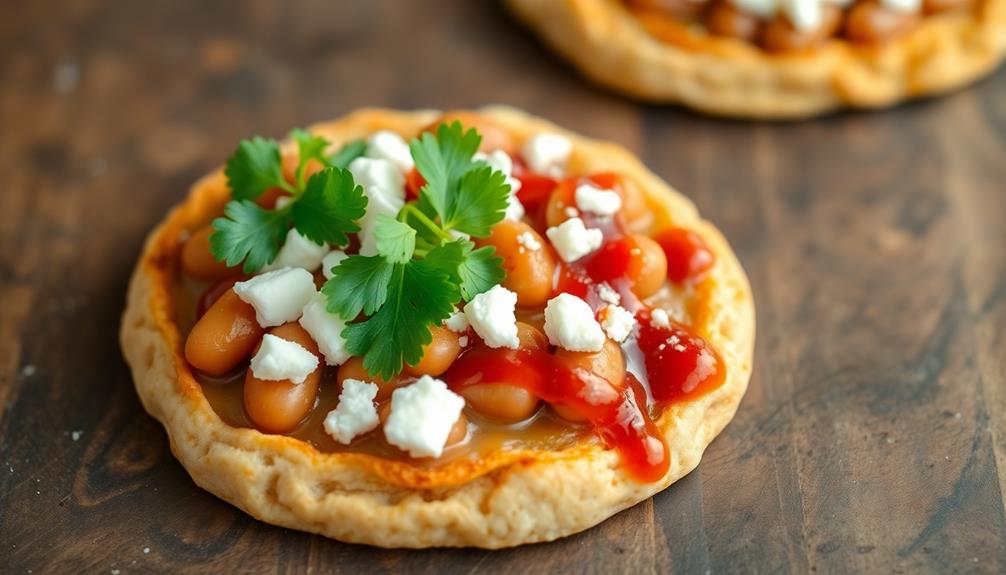Agua fresca, the vibrant and refreshing Mexican drink, will transport you on a delightful journey. For centuries, these colorful beverages have blended fresh fruits, flowers, seeds, or grains with water and a touch of sweetness. Imagine sipping on a cool, thirst-quenching watermelon agua fresca or savoring the tangy-sweet notes of tamarind. It's no wonder this versatile drink is an integral part of Mexican culture and cuisine, offering a healthy alternative to sugary sodas. With its array of natural flavors and vibrant hues, you'll be craving more – and there's so much more to discover about this beloved beverage.
Key Takeaways
- Agua Fresca is a traditional Mexican beverage with origins tracing back to ancient Mesoamerican civilizations.
- It is made by blending fresh fruits, flowers, seeds, or grains with water and sweetener, resulting in a refreshing and flavorful drink.
- Popular flavors of Agua Fresca include watermelon, tamarind, and hibiscus, known for their vibrant colors and natural tastes.
- The simple formula of blended fruit, water, and sweetener makes Agua Fresca a versatile beverage that can be enjoyed as a thirst-quencher or used as a cocktail base.
- Agua Fresca represents a connection to Mexican culture and is often enjoyed during the summer months for its refreshing and health-promoting properties.
History
The origins of agua fresca can be traced back to ancient Mesoamerican civilizations, where indigenous communities have long enjoyed these refreshing fruit-infused beverages.
Agua fresca, which translates to "fresh water," is a traditional Mexican drink that's been quenching thirsty folks for centuries. These tasty concoctions are made by blending fresh fruits, flowers, seeds, or even grains with water and a bit of sweetener.
You might find refreshing flavors like watermelon, tamarind, or hibiscus, each offering a unique twist on this beloved beverage.
Agua fresca has a light, thirst-quenching texture that's perfect for cooling down on a hot day. The vibrant colors and natural flavors make it a delightful treat that's become a beloved part of Mexican culture and cuisine.
Whether you're exploring a bustling market or relaxing in a tranquil courtyard, sipping on a glass of refreshing agua fresca is sure to transport you to the warmth and vibrancy of traditional Mexican life.
Recipe
Agua fresca, which translates to "fresh water" in Spanish, is a refreshing and lightly sweetened fruit-infused water that's a popular beverage throughout Mexico and Latin America. One of the most popular types of agua fresca is made with fresh cantaloupe, but other fruits such as watermelon, cucumber, and mango are also commonly used. To make agua fresca, the fruit is blended with water, sugar, and sometimes a squeeze of lime juice, and then strained to remove any pulp. It’s a perfect drink for hot summer days and pairs well with spicy foods like the aguachile recipe, a Mexican dish made with shrimp marinated in a spicy green chile sauce.
It's the perfect thirst-quencher on a hot day, and the options for flavors are endless.
The basic formula for making agua fresca is simple: blended fruit, water, and a touch of sweetener. The result is a vibrant and flavorful drink that showcases the natural sweetness of ripe fruit.
Agua fresca is a versatile beverage that can be enjoyed on its own or used as a base for cocktails.
Ingredients:
- 4 cups cubed watermelon (or other fruit of your choice)
- 4 cups water
- 2-3 tablespoons granulated sugar (or honey/agave, to taste)
- Juice of 1 lime (optional)
- Ice cubes
Instructions:
In a blender, combine the cubed fruit, water, and sweetener of your choice. Blend until smooth and the sugar has dissolved.
Taste and adjust sweetener as needed. Pour the agua fresca over ice and stir in the lime juice, if using. Serve immediately.
Tips:
- For a thicker texture, use fewer cups of water. Adjust to your desired consistency.
- Try different fruit combinations like pineapple, mango, cantaloupe, or a mix of berries.
- Add a sprig of fresh mint or a slice of lemon/lime for garnish and extra flavor.
- Refrigerate any leftover agua fresca for up to 3 days.
Cooking Steps
First, wash and chop the fresh fruit you've selected.
Then, add your favorite sweetener to taste.
Step 1. Wash and Chop Fruit Ingredients
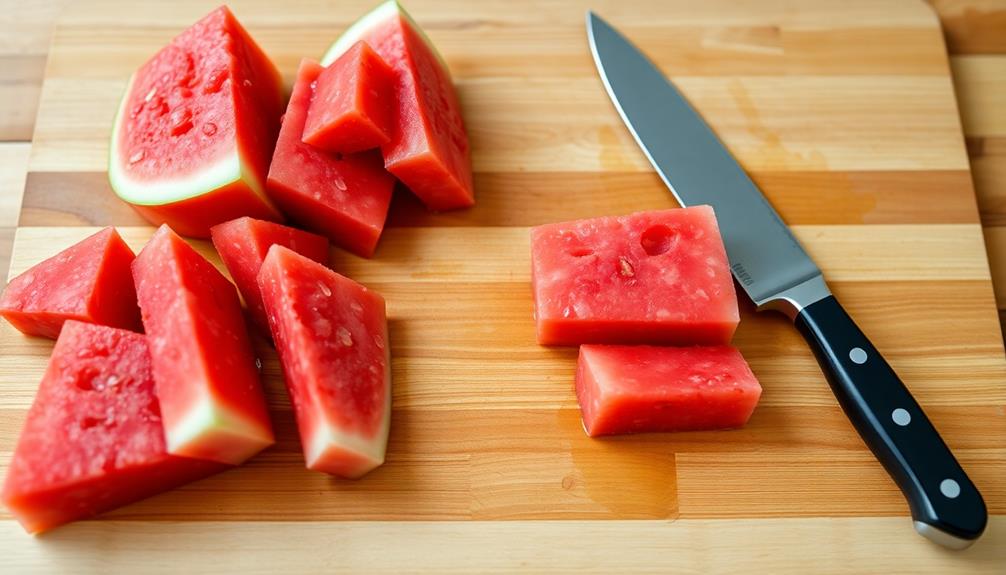
Washing and chopping the fruit ingredients is the next step in creating your refreshing Agua Fresca. First, thoroughly rinse your fruit under cool, running water. This helps remove any dirt, chemicals, or impurities.
Next, grab a clean cutting board and a sharp knife. Carefully slice your fruit into bite-sized pieces. For melons, peel off the tough outer skin first before cutting.
When working with citrus fruits like limes or lemons, be sure to zest the peel before juicing – that way, you can use both the juice and the flavorful zest in your Agua Fresca.
As you chop, keep an eye out for any bruised or damaged spots, and discard those parts. Once all your fruit is prepped, give it a gentle toss to mix the flavors together.
You're one step closer to creating a delightfully refreshing beverage!
Step 2. Add Sweetener
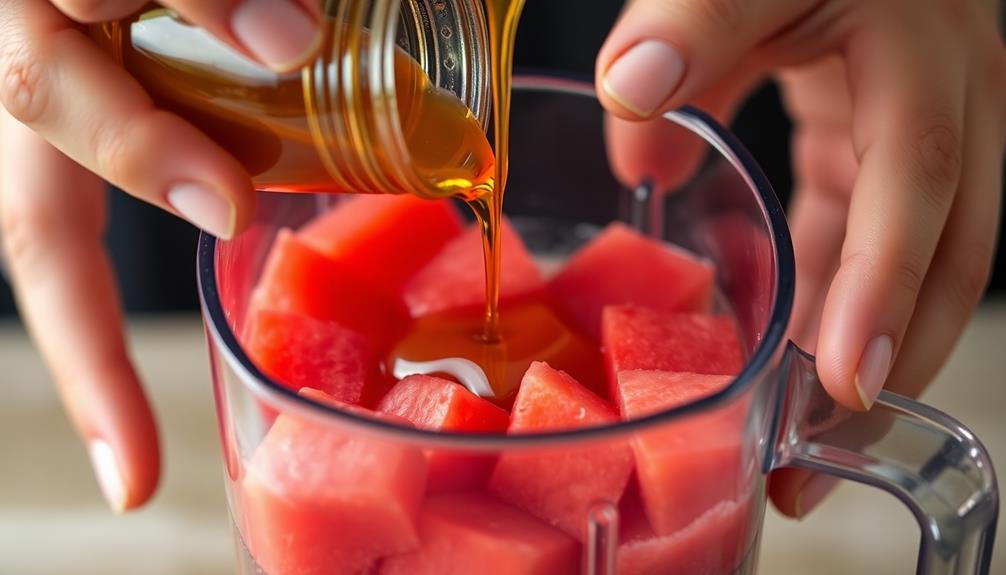
With your fruit chopped and ready, it's time to add a touch of sweetness to your Agua Fresca. Depending on the sweetness of your fresh fruit, you may need to add a bit of sugar or honey to balance the flavors.
Start by adding a small amount, perhaps a tablespoon or two, and give it a gentle stir. Taste your Agua Fresca and add more sweetener if needed, a little at a time, until it reaches your desired level of sweetness.
Be careful not to overdo it, as you want the natural fruit flavors to shine through. The beauty of Agua Fresca is its refreshing and lightly sweet taste, so find the perfect balance that tantalizes your taste buds.
Once you've added the sweetener, give your Agua Fresca a final stir and it's ready to serve over ice, garnished with a slice of the fruit you used.
Step 3. Blend All Ingredients Thoroughly
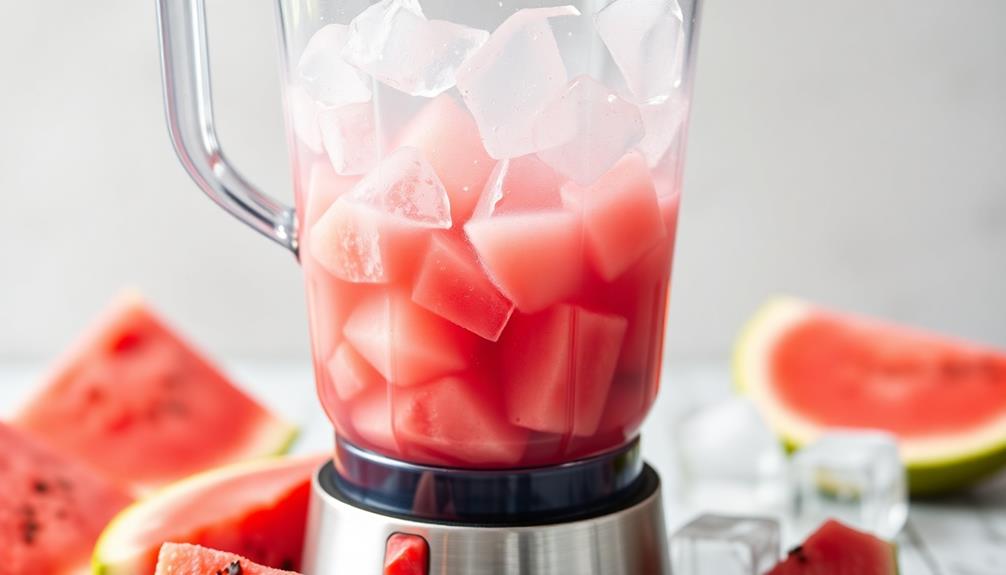
After adding your sweetener, it's time to blend all the ingredients thoroughly.
Grab your trusty blender and get ready to whirl up a delightful drink! Carefully pour in the water, fruit, and sweetener. Make sure everything is evenly distributed.
Now, press that blender button and watch as the mixture swirls together into a smooth, uniform consistency. Listen to the satisfying hum as the blades do their magic.
Keep blending until the beverage is free of any lumps or chunks. The goal is a silky-smooth texture that will delight your taste buds.
Once it's all blended to perfection, give it a quick stir to incorporate any remaining bits. Your refreshing Agua Fresca is now ready to serve over ice or enjoyed right away.
The vibrant colors and enticing aroma will have you eager to take the first sip. Get ready to quench your thirst with this delightful homemade treat!
Step 4. Strain and Discard Solids
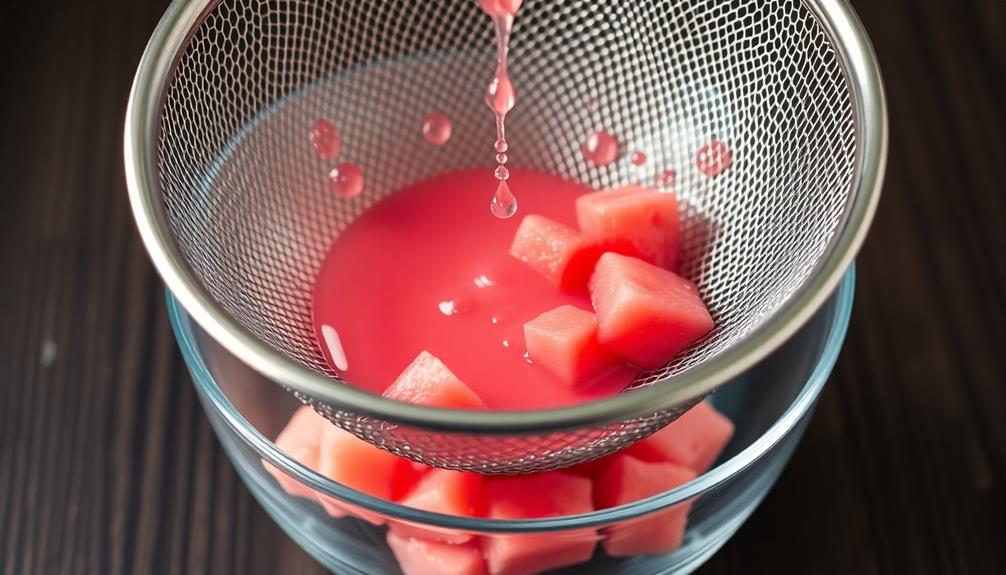
Once your ingredients have been thoroughly blended, it's time to strain the mixture.
Grab a fine-mesh strainer or cheesecloth and place it over a clean bowl. Carefully pour the blended liquid through the strainer, letting the vibrant, fruity nectar drip down. You'll notice the strainer catching all the tiny seeds, pulp, and other solids from the fruits and herbs you used.
Don't worry – this is perfectly normal! Those bits and pieces add great flavor, but you want a smooth, refreshing beverage, so it's best to remove them.
Once you've strained all the liquid, you can discard the solids left behind. Give the strainer a gentle shake to get every last drop of that delicious agua fresca.
Your final step is to transfer the strained liquid to a pitcher or serving container. Now you're ready to pour, garnish, and enjoy your homemade, freshly blended agua fresca!
The tart, sweet flavors are sure to quench your thirst on a hot day.
Step 5. Chill Before Serving
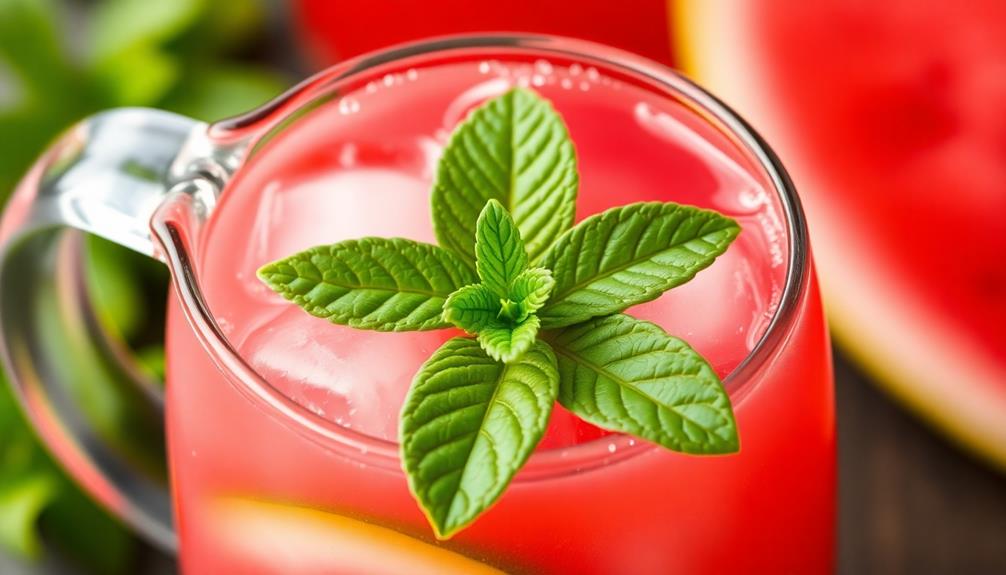
Chilled to perfection, your freshly strained agua fresca will now reach its full refreshing potential. Simply pop the pitcher into the fridge for 30 minutes to an hour, or until the beverage is nice and cold.
Ah, there's nothing quite like that first sip of icy-cool, fruity goodness on a hot summer day! The chill enhances all the bright, vibrant flavors, making each taste an absolute delight.
Once properly chilled, your agua fresca is ready to serve. Grab some tall glasses and fill them up, then garnish with a slice of fruit or sprig of mint for a touch of extra style.
Go ahead, take a sip and let that refreshing sensation wash over you. Ahh, perfection! Your family and friends are sure to love this thirst-quenching treat.
Final Thoughts
Agua fresca, the refreshing Mexican beverage, leaves a lasting impression on those who savor its lively flavors. You can't help but smile as the vibrant colors and sweet aroma dance across your senses.
Whether it's the zesty lime, the juicy watermelon, or the soothing hibiscus, each sip transports you to a sun-drenched plaza, where the rhythm of life moves to the beat of a mariachi band.
But the true magic of agua fresca lies in its versatility. It's the perfect thirst-quencher on a hot summer day, but it also shines as a mixer, adding a burst of natural sweetness to your favorite cocktails.
And let's not forget its health benefits – packed with vitamins and minerals, it's a refreshing alternative to sugary sodas.
Frequently Asked Questions
How Long Can Agua Fresca Be Stored?
You can typically store this beverage for 3-5 days in the fridge. Its shelf life depends on the ingredients used and how it's stored. Be sure to keep it chilled and consume it within a week for best quality.
Can Agua Fresca Be Frozen?
You can certainly freeze the beverage. Doing so will extend its shelf life, though the texture and flavor may change slightly upon thawing. Consider experimenting to see if freezing works for your preferred Agua Fresca recipe.
Is Agua Fresca Suitable for Diabetics?
As a diabetic, you'll want to carefully consider the sugar content in any beverage before enjoying it. Some refreshing options may be better suited to your dietary needs than others, so it's wise to check the nutritional information.
What Are the Health Benefits of Agua Fresca?
You'll be glad to know that drinking refreshing beverages can provide various health benefits. They can help hydrate your body, support immune function, and even promote healthy digestion – all important for your overall well-being.
Can Agua Fresca Be Used in Cocktails?
Yes, you can absolutely use refreshing agua fresca in cocktails! The fruit-infused waters add a bright, natural sweetness that complements a variety of spirits. Get creative and enjoy some delightful agua fresca-based cocktails.




